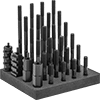Filter by
Thread Size
Material
Fastener Strength Grade/Class
Finish
System of Measurement
Thread Spacing
Specifications Met
Drive Style
Tensile Strength
Thread Direction
Thread Fit
Socket Head Profile
DFARS Specialty Metals
Export Control Classification Number (ECCN)
Fastening and Joining
Fabricating and Machining
Material Handling
Measuring and Inspecting











































